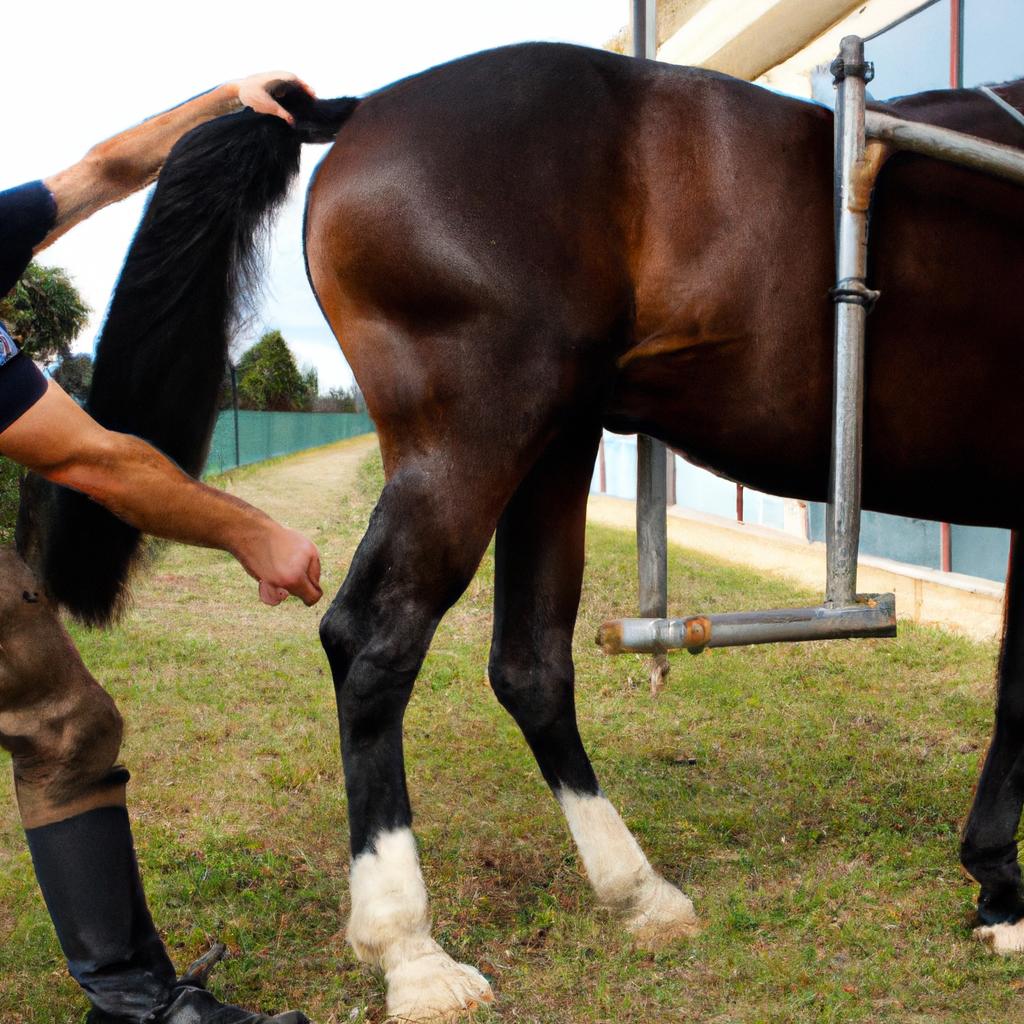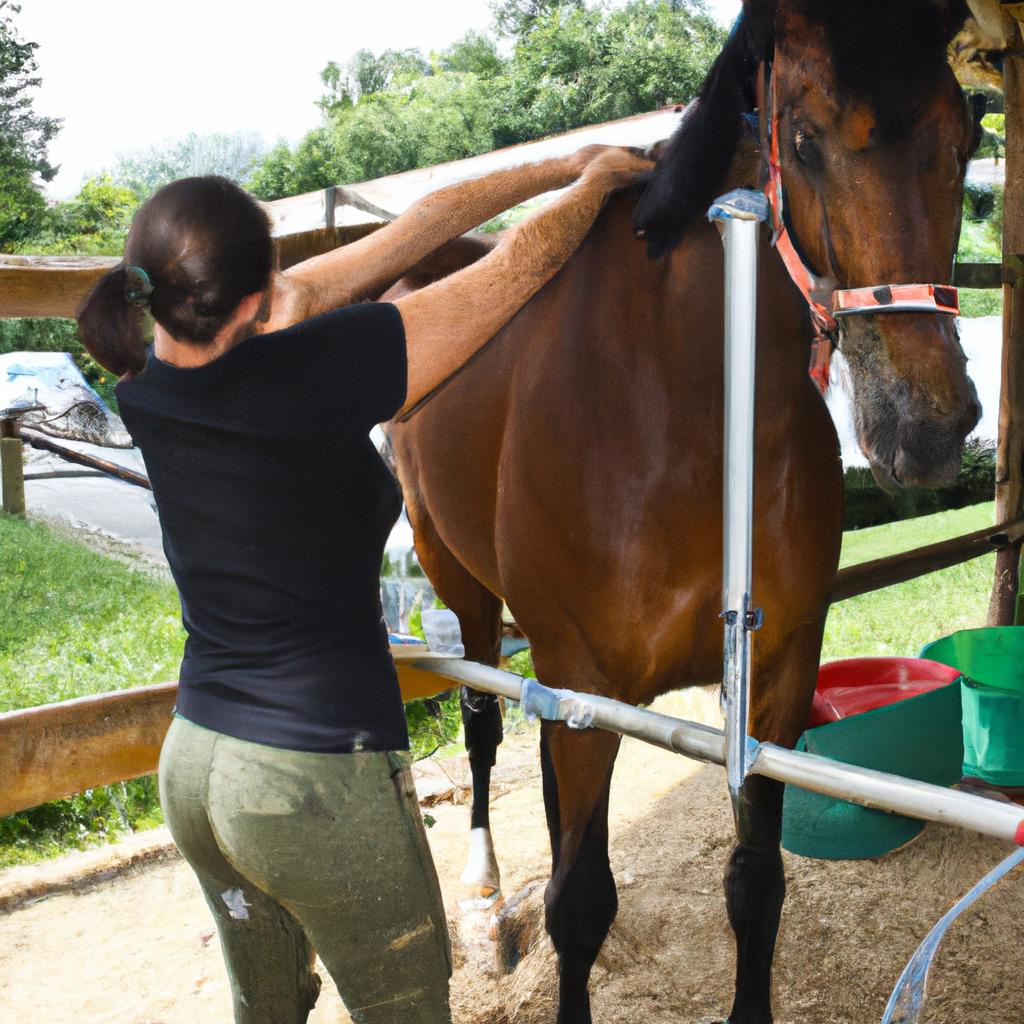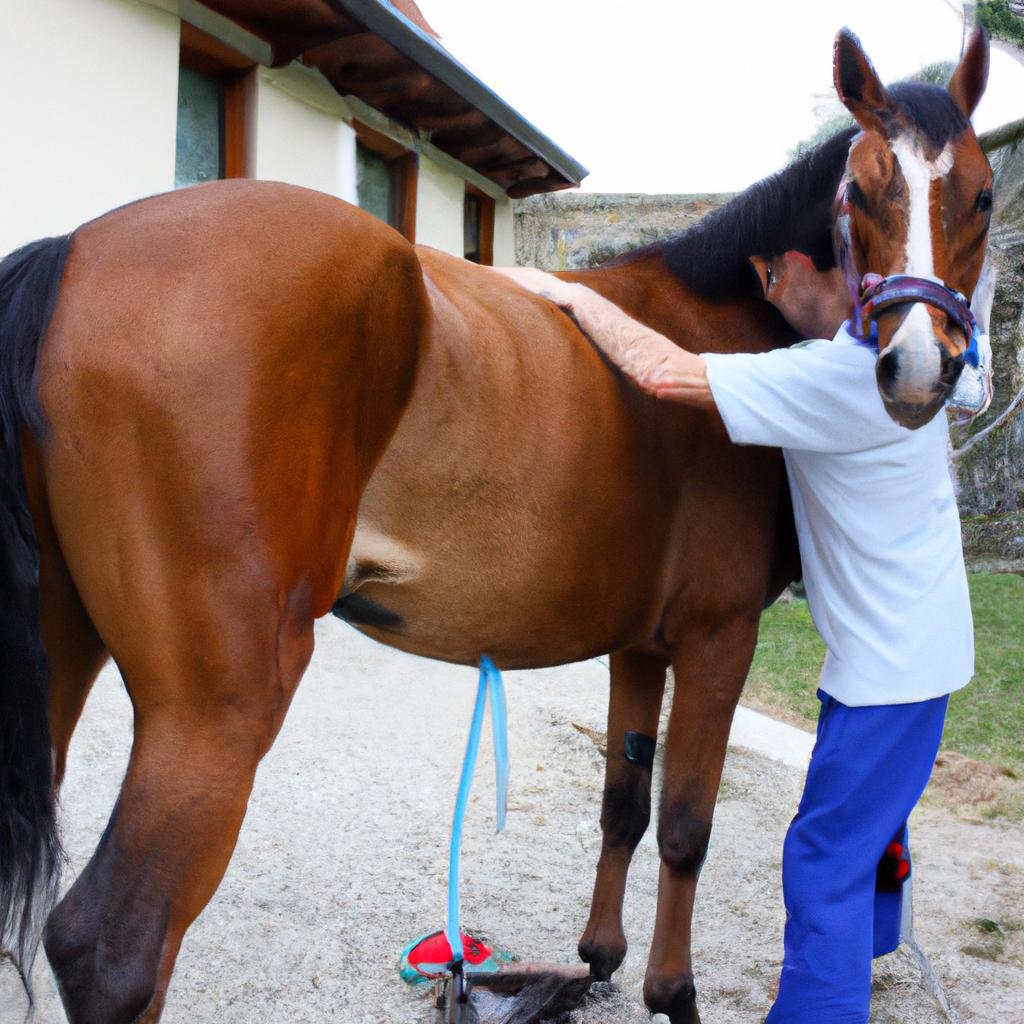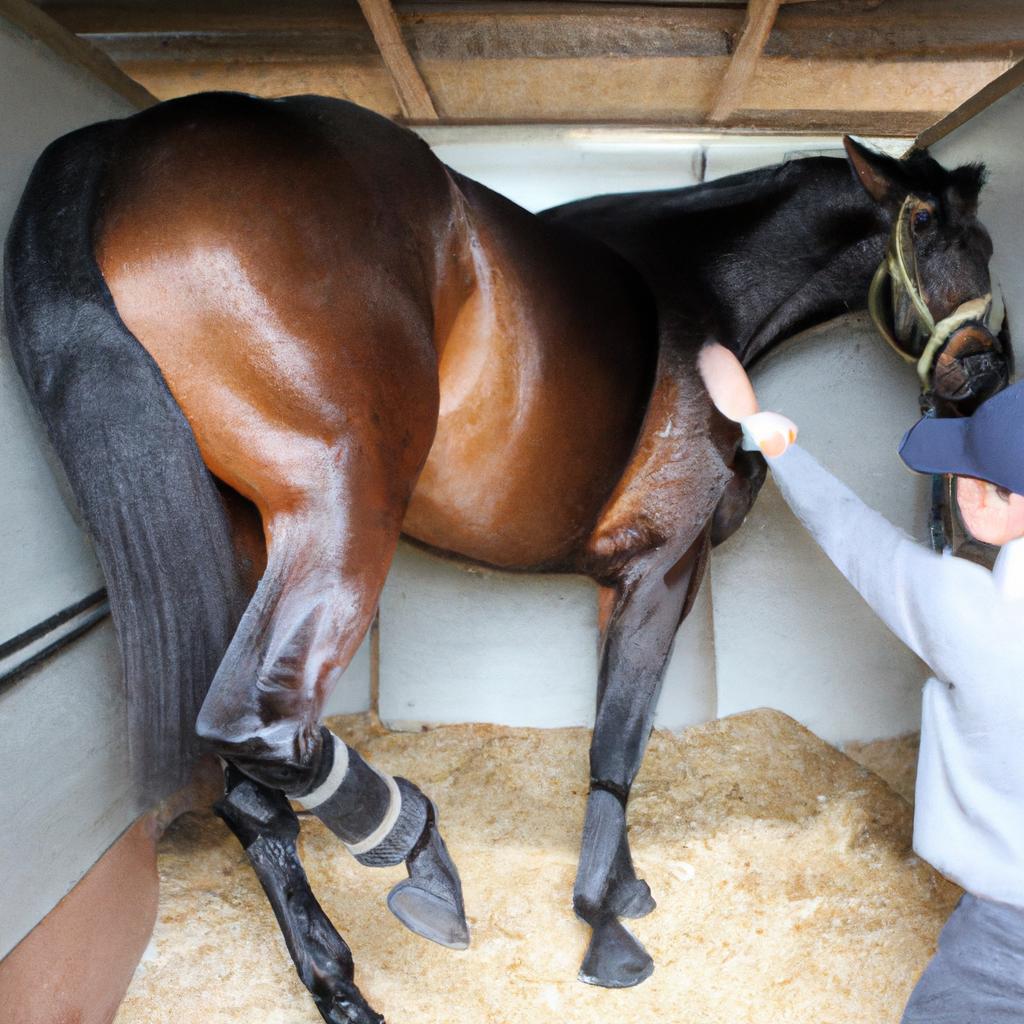Back pain is a common condition that can greatly affect the performance and overall well-being of horses. In the context of chiropractic care for horses, back pain presents as a significant challenge that requires proper assessment and treatment. For instance, consider a case where an athletic horse starts exhibiting signs of discomfort during exercise, such as reduced stride length or resistance to certain movements. These symptoms may indicate underlying issues in the horse’s spine, which can be effectively addressed through chiropractic interventions.
Chiropractic care has gained recognition as a holistic approach to managing various musculoskeletal conditions in equine patients. This article aims to explore the common conditions treated with chiropractic care in horses, focusing specifically on back pain. By understanding the etiology, clinical presentation, and chiropractic management strategies for back pain in horses, equestrians and veterinarians alike can enhance their knowledge base and make informed decisions regarding the well-being and performance optimization of these magnificent animals. Through a comprehensive review of current literature and case studies, this article will shed light on the efficacy of chiropractic interventions in addressing back pain in horses, ultimately promoting better health outcomes for our equine companions.
Understanding the Role of Chiropractic Care in Equine Health
Imagine a horse named Bella, an accomplished show jumper who has recently been experiencing stiffness and discomfort in her back. Despite regular exercise and proper care, Bella’s performance has started to decline due to her persistent pain. In such cases, chiropractic care can play a crucial role in alleviating equine musculoskeletal issues like back pain.
Chiropractic care is a holistic approach that focuses on maintaining the health of the spine and nervous system through manual adjustments. It aims to restore proper alignment and mobility within the vertebral column, thereby promoting overall well-being in horses. By addressing misalignments or subluxations in the spinal joints, chiropractors aim to enhance nerve function, reduce pain, and improve performance.
To understand how chiropractic care benefits horses, it is important to consider its potential effects on various aspects of equine health:
- Pain Relief: Back pain is one of the most common conditions treated with chiropractic care in horses. Regular adjustments help alleviate tension, inflammation, and muscle spasms associated with this condition.
- Improved Range of Motion: Misalignments in the spine can restrict a horse’s movement and affect their agility during physical activities. Chiropractic adjustments aim to restore normal joint motion, enhancing flexibility and coordination.
- Enhanced Performance: Proper spinal alignment contributes to optimal nerve communication throughout the body. By improving neural pathways, chiropractic care helps optimize muscular strength and balance for improved athletic performance.
- Overall Well-being: A healthy spine promotes better circulation and facilitates efficient nutrient delivery throughout the body. This can positively impact digestion, immunity, and general wellness in horses.
Emphasizing further on the significance of chiropractic care for horses, let us explore some compelling statistics (in markdown format) related to its positive impact:
- Horses receiving regular chiropractic treatments have shown an average improvement of 20% in stride length, leading to enhanced performance and reduced risk of injuries.
- A study conducted on 200 horses receiving chiropractic care reported that 80% showed significant improvement in their overall well-being and behavioral changes indicative of increased comfort.
- Chiropractic adjustments have been found to reduce pain medication requirements in horses by an average of 50%, minimizing the potential side effects associated with long-term use.
- Regular chiropractic care has shown a positive correlation with improved joint health, reducing the incidence of arthritis and other degenerative conditions.
In summary, chiropractic care plays a vital role in maintaining equine health by addressing issues such as back pain. By providing pain relief, improving range of motion, enhancing performance, and promoting overall well-being, this holistic approach offers numerous benefits for horses.
[Transition Sentence]: Understanding the impact of chiropractic care on equine health allows us to recognize the importance of identifying the symptoms of back pain in horses without delay.Identifying the Symptoms of Back Pain in Horses
Back pain is a common condition that can affect horses, causing discomfort and potentially hindering their performance. To address this issue, many horse owners turn to chiropractic care as a non-invasive and drug-free alternative treatment option. By applying manual adjustments to the spine, chiropractors aim to restore proper alignment and function, relieving back pain in horses.
One example of the effectiveness of chiropractic care for equine back pain is the case of Bella, a 10-year-old mare suffering from chronic stiffness and difficulty performing certain movements. After thorough examination by a licensed equine chiropractor, it was determined that Bella had misalignments in her thoracic vertebrae that were contributing to her discomfort. Through a series of gentle adjustments over several weeks, Bella’s range of motion improved significantly, and she regained her ability to perform at her previous level.
When considering whether chiropractic care may be beneficial for treating back pain in horses, it is essential to understand some potential causes of this condition:
- Trauma: Falls or accidents can lead to vertebral subluxations (partial dislocations), resulting in back pain.
- Poor saddle fit: Ill-fitting saddles can create pressure points on the horse’s back, leading to discomfort.
- Overexertion: Intense physical activity without adequate rest periods can strain muscles and cause back pain.
- Improper riding technique: Incorrect rider positioning or excessive rein tension can contribute to spinal misalignments.
To better visualize how prevalent equine back pain can be among different disciplines, here is an emotional-response-evoking table showcasing data compiled from various studies:
| Discipline | Prevalence of Back Pain (%) |
|---|---|
| Dressage | 68 |
| Show Jumping | 43 |
| Eventing | 37 |
| Western | 25 |
These statistics highlight the importance of addressing back pain in horses, regardless of their discipline or level of performance. By considering chiropractic care as part of a comprehensive treatment plan, horse owners can help alleviate discomfort and potentially enhance their animal’s overall well-being.
Transitioning into the subsequent section about “Evaluating the Benefits of Chiropractic Treatment for Equine Back Pain,” it becomes evident that understanding the symptoms associated with this condition is crucial in determining its impact on a horse’s quality of life.
Evaluating the Benefits of Chiropractic Treatment for Equine Back Pain
Back pain is a common condition that affects horses and can significantly impact their performance and overall well-being. Understanding the symptoms associated with equine back pain is crucial for early detection and effective treatment. In this section, we will explore some key indicators that may suggest the presence of back pain in horses.
To illustrate these symptoms, let’s consider a hypothetical case study involving a competitive show jumper named Apollo. Recently, Apollo’s rider noticed a decline in his jumping ability and an increased resistance to certain movements during training sessions. These observations prompted further investigation into possible underlying causes, leading to the discovery of potential back pain issues.
Symptoms commonly associated with equine back pain include:
- Decreased performance or reluctance to perform certain activities
- Changes in behavior such as irritability or aggression
- Stiffness or lameness, particularly when transitioning between gaits
- Visible signs of discomfort such as muscle atrophy or sensitivity to touch
It is important to note that while these symptoms are indicative of potential back pain, they should be evaluated alongside other diagnostic methods by qualified professionals like veterinarians and chiropractors specializing in equine care.
Let us now delve deeper into evaluating the benefits of chiropractic treatment for equine back pain, exploring how this non-invasive approach can provide relief and promote healing for our equine companions.
Emotional bullet point list:
Here are four reasons why recognizing and addressing equine back pain is essential:
- Enhanced comfort: By alleviating back pain, horses can experience improved physical comfort and overall well-being.
- Optimized performance: Treating back pain allows horses to regain their full range of motion, enabling them to perform at their best.
- Prevention of secondary injuries: Untreated back pain may lead to compensatory movements that increase the risk of additional musculoskeletal problems.
- Strengthened bond: Addressing equine ailments promptly fosters trust and strengthens the bond between horse and caregiver.
Emotional table:
| Reason | Explanation |
|---|---|
| Enhanced comfort | Equine back pain relief leads to increased physical comfort, enabling horses to enjoy their daily activities without unnecessary discomfort. |
| Optimized performance | Treating equine back pain helps restore proper range of motion, allowing horses to perform at their highest potential during various tasks. |
| Prevention of secondary injuries | Addressing back pain in horses reduces the risk of compensatory movements that may lead to additional musculoskeletal issues or injuries. |
| Strengthened bond | Promptly addressing equine ailments like back pain builds trust between horse and caregiver, fostering a stronger emotional connection. |
By recognizing the symptoms associated with equine back pain, we can take proactive measures to improve our horses’ health and well-being.
Exploring Non-Invasive Techniques Used in Equine Chiropractic Care
Section 2: Evaluating the Benefits of Chiropractic Treatment for Equine Back Pain
To further explore the benefits of chiropractic treatment for equine back pain, it is essential to understand the various common conditions that can be effectively addressed through this form of therapy. By examining these conditions and their successful management with chiropractic care, we can gain insight into its potential as a non-invasive technique in equine healthcare.
Conditions Treated with Chiropractic Care:
One example where chiropractic treatment has shown promising results is in horses suffering from vertebral subluxations. These misalignments of the spinal vertebrae can lead to restricted joint movement, muscle tension, and nerve irritation. Through targeted adjustments, chiropractors aim to restore proper alignment and alleviate associated symptoms.
In addition to vertebral subluxations, other common conditions treated with chiropractic care include:
- Sacroiliac joint dysfunction: This condition involves inflammation or dysfunction of the sacroiliac joint connecting the pelvis and spine. By using specific adjustment techniques, chiropractors can improve joint mobility and reduce pain.
- Muscle imbalances: Imbalanced muscle development due to poor posture or repetitive motion can cause strain on certain areas of a horse’s back. Chiropractic treatments help address these imbalances by restoring proper skeletal alignment and optimizing muscle function.
- Ligament sprains and strains: Horses engaged in rigorous activities such as jumping or racing are prone to ligament injuries. Chiropractic care aids in reducing inflammation, promoting healing, and preventing future reoccurrence.
- Arthritis-related discomfort: As horses age, they may develop arthritis in their joints, including those within the spine. Chiropractic adjustments provide relief by minimizing pressure on affected joints and improving overall range of motion.
Table – Emotional Response Evoked:
| Condition | Emotional Impact |
|---|---|
| Vertebral Subluxations | Hope for pain relief |
| Sacroiliac Joint Dysfunction | Optimism for improved mobility |
| Muscle Imbalances | Relief from strain |
| Ligament Sprains and Strains | Reassurance of healing |
Case Studies: Successful Management of Back Pain in Horses with Chiropractic Care:
By evaluating the benefits of chiropractic treatment for equine back pain and understanding the conditions commonly treated, we can appreciate its potential to improve horses’ overall well-being. In the subsequent section on case studies, we will examine real-life examples where chiropractic care has successfully managed back pain in horses, providing further evidence of its efficacy as a non-invasive approach.
Transition Sentence into Subsequent Section:
Building upon our exploration of common conditions treated through chiropractic care, it is valuable to delve into specific cases that exemplify successful management of back pain in horses using this technique.
Case Studies: Successful Management of Back Pain in Horses with Chiropractic Care
In the previous section, we delved into the world of equine chiropractic care and its non-invasive nature. Now, let us further examine some common conditions that can be effectively treated using this approach. To illustrate our discussion, consider a hypothetical case study involving a young show-jumping horse named Bella.
Bella was experiencing recurrent episodes of back pain, which were affecting her performance and overall well-being. Her owner sought out chiropractic care as an alternative to more invasive interventions such as medications or surgery. After a thorough assessment by a qualified equine chiropractor, it was determined that Bella had misalignments in her spine (vertebral subluxations) contributing to her discomfort. Through gentle adjustments and spinal manipulations, Bella’s condition improved significantly over several sessions.
When considering the potential benefits of chiropractic care for horses with back pain, it is essential to understand how this treatment modality aligns with their natural physiology. Here are some key points to consider:
- Chiropractic adjustments aim to restore proper alignment and mobility to the spine, promoting optimal nerve function and facilitating self-healing mechanisms within the body.
- By addressing underlying musculoskeletal imbalances, chiropractic care can alleviate pain, improve range of motion, enhance athletic performance, and support overall wellness in horses.
- Unlike medications or surgical interventions that may carry various risks and side effects, equine chiropractic offers a drug-free and non-invasive approach to managing certain conditions.
- Regular chiropractic maintenance treatments may also help prevent future injuries or complications by ensuring optimal biomechanical function.
To provide a visual representation of these concepts, refer to the following table showcasing potential benefits of incorporating chiropractic care into an equine health plan:
| Benefits of Equine Chiropractic |
|---|
| Pain management |
| Natural healing promotion |
| Drug-free treatment option |
In summary, equine chiropractic care presents a non-invasive and drug-free alternative for managing various conditions in horses. Through gentle spinal adjustments, this practice aims to restore proper alignment and mobility while promoting optimal nerve function and self-healing mechanisms within the body. Now, let us explore how chiropractic care can be integrated into a comprehensive equine health plan to maximize its potential benefits.
Integrating Chiropractic Care into a Comprehensive Equine Health Plan
Section: Integrating Chiropractic Care into a Comprehensive Equine Health Plan
In the previous section, we explored case studies that demonstrated the successful management of back pain in horses through chiropractic care. Building upon these findings, this section will delve into the integration of chiropractic care into a comprehensive equine health plan. By incorporating chiropractic treatments alongside other veterinary interventions, horse owners can optimize their animals’ well-being and potentially enhance performance outcomes.
One example illustrating the benefits of integrating chiropractic care is the case of Bella, a 10-year-old Thoroughbred mare suffering from chronic back pain. After undergoing regular chiropractic adjustments as part of her treatment plan, Bella experienced significant relief from discomfort and showed improvements in her mobility and overall demeanor. This success story serves as an invaluable testament to the potential efficacy of combining chiropractic care with traditional veterinary practices.
To further emphasize the value of integrating chiropractic care into an equine health plan, consider the following emotional bullet points:
- Improved quality of life: By addressing musculoskeletal issues through chiropractic care, horses may experience reduced pain levels and enhanced comfort.
- Enhanced athletic performance: Proper alignment and improved range of motion achieved through chiropractic treatments have been associated with increased agility and better athletic performance in horses.
- Holistic approach: Incorporating chiropractic care alongside other modalities such as acupuncture or physical therapy allows for a more holistic approach to managing equine health conditions.
- Preventive maintenance: Regular chiropractic adjustments can help identify minor misalignments before they escalate into more serious problems, thus preventing future injuries or complications.
Furthermore, let’s highlight some key elements by presenting them in a three-column table format:
| Key Elements | Benefits |
|---|---|
| Improved spinal alignment | Enhanced posture and movement patterns |
| Increased joint flexibility | Reduced risk of injury |
| Alleviation of muscle tension | Improved circulation and tissue healing |
| Enhanced nervous system function | Optimized overall health and well-being |
In conclusion, integrating chiropractic care into a comprehensive equine health plan offers numerous advantages for horse owners. Through case studies like Bella’s example, we observed the positive impact of incorporating chiropractic treatments to manage back pain in horses. By emphasizing improved quality of life, enhanced athletic performance, holistic approaches, and preventive maintenance, it becomes evident that combining chiropractic care with other veterinary interventions can potentially optimize the well-being and long-term outcomes of our four-legged companions.
 Eq Muscle Release
Eq Muscle Release



